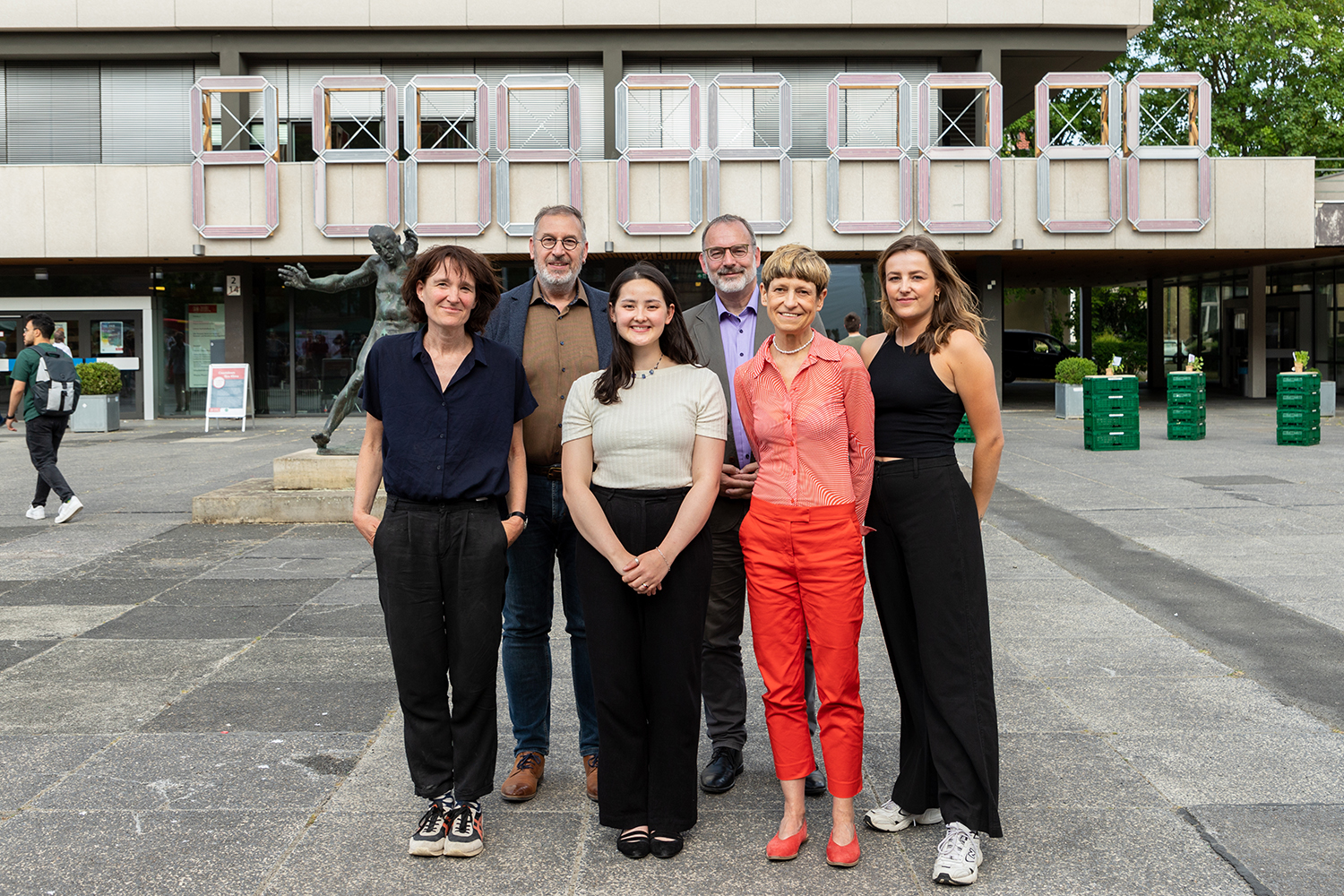The clock is ticking: TU Braunschweig’s ClimateCrisisClock launched Countdown for the climate at the Forum Building
How much time do we have left to limit global warming to 1.5 degrees Celsius? The remaining years, days, hours, minutes and seconds are now displayed on a ClimateCrisisClock at Technische Universität Braunschweig. Ten large numbers were built by architecture students and the student engineering office StudING, each about 2.5 metres high and 1.5 metres wide. As part of the TUmorrow Days, TU President Angela Ittel, together with all those involved, launched the climate clock on 15 June 2023, which counts down time in rapid steps at the Forum Building.

The ClimateCrisisClock was started at TU Braunschweig on 15 June. With (from left) Professor Folke Köbberling from the Institute of Architecture-Related Arts, City Councillor Holger Herlitschke, architecture student and co-initiator Kathrin Philipps, Vice President for Digitalisation and Sustainability Professor Manfred Krafczyk, TU President Angela Ittel and architecture student and co-initiator Kathrin Philipps. Picture credits: Kristina Rottig/TU Braunschweig
“Climate change is one of the greatest challenges of our time. With the ClimateCrisisClock, we want to create awareness of the urgency with which we must act to curb the negative effects of climate change,” says TU Braunschweig President Angela Ittel. “We hope that the climate clock will inspire students and staff at our university, as well as the wider public, to take action and find solutions that will enable a more sustainable future. I would like to sincerely thank the students who designed and built the ClimateCrisisClock for the wonderful idea and their commitment!”
How much time is left to act?
The idea to introduce a ClimateCrisisClock at TU Braunschweig stems from the climate justice movement “Students for Future”. After an impromptu – issued by Professor Dan Schürch’s Institute of Building Design – the students had a variety of design approaches as a basis. The 7-segment design by Adrian Borchers was implemented and, after a jury vote and further deliberations, was chosen as the winning design.
More than 60 students were involved in the project over the past few semesters – from design to implementation to the final construction at the Forum Building. The students were supported by the Institute for Architecture-Related Art under the direction of Professor Folke Köbberling, in whose rooms in Querumer Forst they assembled the figures from partly donated material. Among other things, the students were able to collect façade panels from containers, which they brought to the institute by cargo bike. Overall, the students paid close attention to working with minimal raw materials. In the end, the number of LED strips was even halved.
“Every tenth of a degree counts!”
Five long LED light strips were attached to each panel of a 7-segment display, i.e. a digit, so that the clock could be seen far across the University Square of TU Braunschweig. Since 15 June, the large red digits have been shining – ¬fixed with a wooden construction to the balcony of the Forum Building and powered by electricity generated by photovoltaic systems on the TU Braunschweig campus.
The clock is now a central element on the TU Braunschweig campus and is intended to highlight the urgency of taking active action against global warming. “With the ClimateCrisisClock, however, we don’t want to deter or even spread fear,” explain Kathrin Philipps and Mia Gutschalk, initiators of the project. “Quite the opposite: we want to show that there is still time to do something, but that we need to act quickly now and that people should individually make room in their everyday lives to reduce CO2 emissions. If we change our behaviour, we can extend the time we have to reach the 1.5 degree target. Every tenth of a degree counts!”
Etienne Neumann of Students for Future adds: “Many people don’t realise how close we are to the Paris 1.5 degree target and the impact of exceeding it.
First climate clock in Braunschweig
All over the world, climate or CO2 clocks draw attention to the climate crisis. For instance, on New York’s “Metronome”, a work of art that originally displayed the current time on an atomic clock. On 19 September 2020, the sentence “The Earth has a deadline” appeared there, followed by the numbers 7:103:15:40:07, which represent the years, days, hours, minutes and seconds until this deadline.
In Braunschweig, this is the first climate clock. “The ClimateCrisisClock keeps us clearly aware that the years coming now will be crucial to preserve the foundations of life for future generations. We have to achieve this as a society, in Germany and worldwide. Braunschweig will make its contribution to this. With the measures of our climate protection concept, we want to achieve the very ambitious goal of greenhouse gas neutrality, if possible, by 2030,” says Braunschweig city councillor Holger Herlitschke, who welcomes the establishment of the ClimateCrisisClock and accompanied its launch.
Role of the university in climate communication
The CO2 clock of the Mercator Research Institute on Global Commons and Climate Change (MCC) illustrates on the website of the climate research institute how much carbon dioxide may be released into the atmosphere in order to limit global warming to a maximum of 1.5 degrees Celsius or 2 degrees Celsius. The ClimateCrisisClock on the Forum building also refers to this data. If the clock were to show 0:000:00:00 one day, the CO2 budget would be used up and the consequences would likely be devastating.
The TUmorrow Days 2023 ended on 15 June with the launch of the climate clock, a panel discussion on the role of the university in climate communication and the Braunschweig Science Slam in cooperation with the Haus der Wissenschaft. Organised by the Green Office, TU Braunschweig’s sustainability office, the TUmorrow Days brought a varied programme of free workshops, lectures and information events on the topic of sustainability to the campus for three days.
TU Braunschweig now invites everyone to visit the ClimateCrisisClock in person and watch the countdown.
